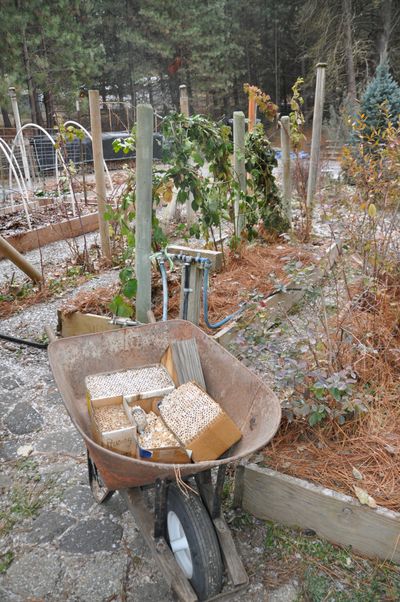Gardening: Last few chores on 2023 garden set up 2024 garden for success

Well, the gardening year has come to an end. I squeaked under the wire of last Thursday’s dusting of snow to get the last of the vegetable garden cleaned up and ready for winter.
I try to do much of the cleanup labor in the fall because spring is busy enough with getting ready to plant to be doing leftover chores.
The first job was to untangle and tie up my blackberry and marionberry vines. The blackberries aren’t too hard to handle because they don’t have thorns. I’m still picking thorns out of my fingers from the marionberries even though I had gloves on. I gather up all the canes into a circle and tie them to the wires.
It was easy to prune out the old canes on my raspberries and tie the new ones to the wire. I leave the canes long and bend them over and tie them to the wire. Too many books tell you to prune them to 6 feet, but why waste the berries they would produce? Over time, raspberry runners have spread through the garden, and I’ve had to become selective as to where I let them take up residence. In my raised beds, not a chance. The ones that are smart enough to come up along the path near some wire mesh get to live.
I also had to do a little gopher hunting while the soil was still soft. One enterprising gopher dared to put up a mound right next to the fence near the blackberry patch. I wasn’t going to tolerate him chewing off the roots of the blackberry plants like he did two years ago. Blackberry plants are expensive. He filled the hole I dug back in, but I haven’t seen any more mounds, so we’ll see.
While I was traveling, the wind brought down a yard full of pine needles and of course those needed to be picked up before the snow buried them (remember last year?).
My trusty riding mower made short work of them, and the nicely shredded needles mulched the tops of my new raised beds. Doing this means I won’t have to weed as much next year.
An extra thick pile went on top of the artichoke plants I’m hoping to shepherd through the winter so I can have big artichokes next summer. The remaining perennials like asters, Autumn Joy sedum and other seedy plants I leave standing in the garden so the birds and small critters can eat the seeds and find shelter amongst them from the weather.
Last, I pulled my boxes of mason bees out of their house and wheeled them off to the garage for the winter. The cold won’t bother them, but the pesky raccoons know they are worth going after. As a note, if you want to add mason bees to your garden next year, now is the time to start planning where you will put them and ordering your supplies and bees.